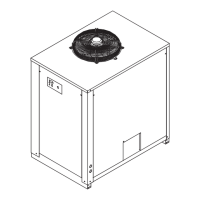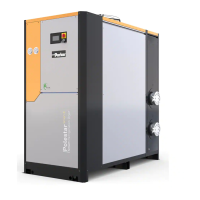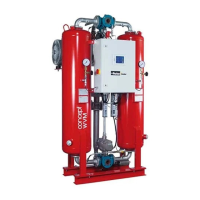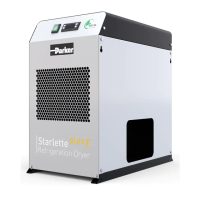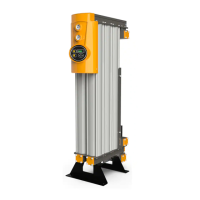TWP/TWB200 – TWP/TWB9000
4
SAFETY AND PRECAUTIONS
Use EXTREME CAUTION when working in the vicinity of the dryer. Adhere to all warning labels on dryer.
Relieve pressure before servicing dryer or associated equipment.
Disconnect power before servicing dryer.
Always wear eye protection when in the vicinity of the dryer. Ear protection is recommended, especially if the dryer is
being operated without mufers. Even when mufers are used, a desiccant vessel blowing down to atmosphere will
raise particles, create more noise than during “normal” operation and may startle an individual not familiar with this
portion of the operation.
The dryer is uses heat to regenerate the desiccant. Any dryer surface may reach temperatures up to 350°F. Do not
touch hot surfaces. Partial insulation is provided to maximize dryer performance. The standard insulation does not
provide complete personnel protection or 100% thermal efciency.
The emergency stop button will cut off 120V control voltage only. Supply voltage is not disconnected.
In the case of an overpressure situation there is a safety relief valve installed on each desiccant vessel designed to
protect the equipment. If the valves are pointed in a hazardous location to operators after dryer installation, they
should be piped to a safe location.
Dryers are designed for fail safe operation. In the event of a power failure, the inlet valves will fail in the open or last
position and the exhaust valves will fail closed. Compressed air will continue to ow through the dryer. When power
is restored, the cycle will continue on from where it left off at the time of the power loss.
Automatic or manual drain valves will eject water, oil, particulates, and air under partial pressure when operated.
Proper precautions must be taken.
Condensate drainage from compressed air systems may contain oil or other contaminants. Follow all applicable
regulations for safe handling and disposal.
Various component failures could cause large air loss and subsequent pressure drop. Preventative maintenance
should be performed to reduce this possibility. If this situation occurs, bypass the dryer immediately to restore
ow and pressure.
Oil in the desiccant bed combined with high regeneration temperature may create a potential for re or
explosion. Proper cooling, pre-ltration, and condensate drainage must be maintained to reduce the possibility
of oil contamination.
Activated alumina dust is considered a nuisance dust. Proper precautions should be taken when handling desiccant.
For more information and for other types of desiccant, refer to the applicable Safety Data Sheet. For disposal of
used desiccant, refer to the local codes and regulations.
NOTE: desiccant contaminated with oil or other foreign substances may be covered under disposal regulations for
the contaminant.
Heated dryers are designed with a cooling cycle after heated regeneration to alleviate high temperatures from the
regenerated desiccant and vessel. It is normal for residual heat to remain in the regenerated vessel. Temperatures
of 200-350°F may be seen at switchover. The residual heat will dissipate quickly once the tower is online at full ow.
Downstream piping and components must be suitable for the elevated temperatures.
DOWNSTREAM AIR TEMPERATURE MAY EXCEED 200°F FOR A DURATION OF 15 MINUTES AFTER DRYING
VESSEL SWITCHOVER! TEMPERATURE CAN EXCEED 350°F AT LOWER FLOW!
